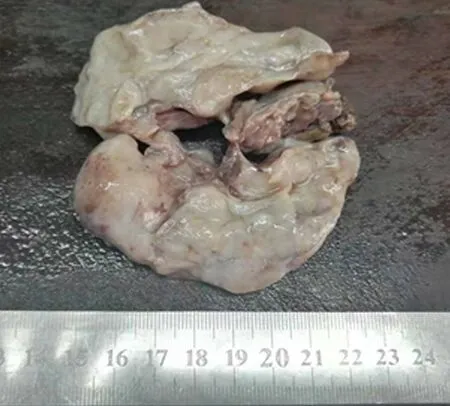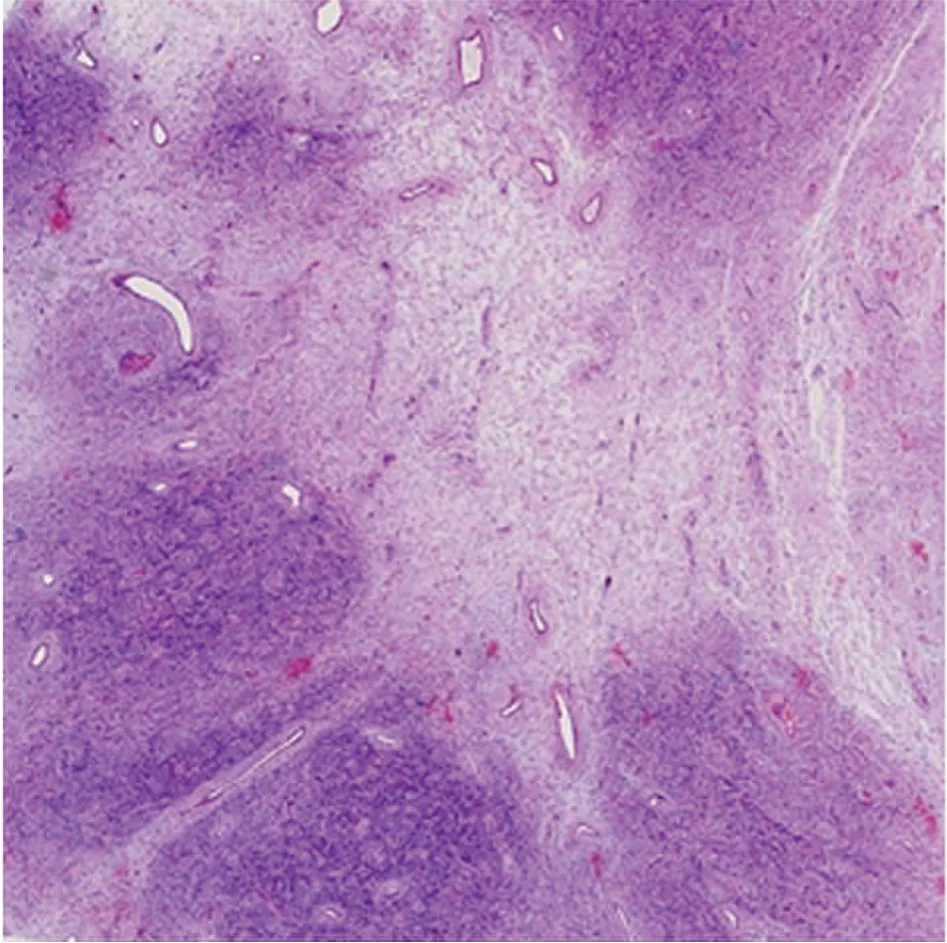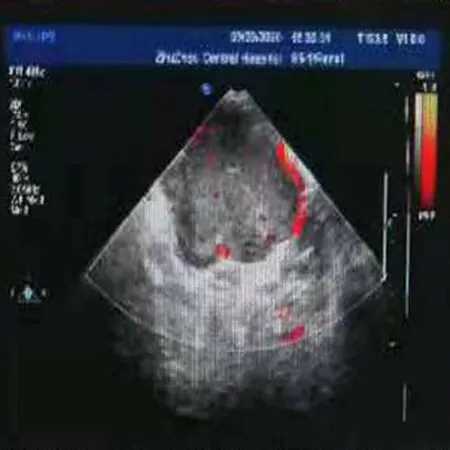Perianal superficial CD34-positive fibroblastic tumor: A case report
Chen-Yan Long, Tao-Li Wang
Chen-Yan Long, The Second Department of General Surgery, Zhuzhou Hospital Affiliated to Xiangya School of Medicine, Central South University, Zhuzhou 412007, Hunan Province,China
Tao-Li Wang, Department of Pathology, Zhuzhou Hospital Affiliated to Xiangya School of Medicine, Central South University, Zhuzhou 412007, Hunan Province, China
Abstract BACKGROUND Superficial CD34-positive fibroblast tumors (SCPFTs) are newly recognized fibroblast and myofibroblast tumors representing intermediate tumors. To the best of our knowledge, fewer than 50 cases have been reported. Perianal SCPFT has not been previously reported.CASE SUMMARY A 55-year-old man was hospitalized upon discovering a painless perianal lump 10 d prior. Physical examination showed a lump of approximately 3 cm × 4 cm in the 7 to 8 o’clock direction in the perianal area. Perianal abscess was considered the primary diagnosis. Lump removal surgery was performed under epidural anesthesia. Postoperative pathology showed a well-circumscribed, soft tissuederived, spindle-cell tumor with strong CD34 positivity by immunohistochemistry. The final diagnosis was perianal SCPFT. There were no complications,and the patient was followed for more than 8 mo without recurrence or metastasis.CONCLUSION We report a case of perianal superficial CD34-positive fibroblast tumor. This rare mesenchymal neoplasm has distinctive histomorphology, which is important for diagnosis. Comprehensive consideration of clinical information, imaging,histology, and immunohistochemistry is important for diagnosis.
Key Words: Superficiality; CD34-positive; Fibroblast tumor; Perianal; Diagnosis; Case report
INTRODUCTION
Superficial CD34-positive fibroblast tumors (SCPFTs) are newly recognized fibroblast and myofibroblast tumors representing intermediate tumors. SCPFT was first reported in 2014[1]. To date, less than 50 cases have been reported. Perianal SCPFT has not been previously reported[2]. Here, we report a case that was misdiagnosed as a perianal abscess before surgery. Informed consent for the publication of these data was obtained from the patient.
CASE PRESENTATION
Chief complaints
A 55-year-old man was hospitalized after he discovered a painless perianal mass.
History of present illness
The patient’s symptoms started 10 d prior to presentation.
History of past illness
The patient had no relevant previous medical history.
Personal and family history
The patient’s family history was unremarkable.
Physical examination
A lump approximately 3 cm × 4 cm could be felt in the 7 to 8 o’clock direction of the perianal area.
Laboratory examinations
After admission to the inpatient ward, laboratory examinations were carried out,which included routine blood tests (Table 1), routine tests for stool plus occult blood,and tests for liver and kidney function, electrolytes, blood coagulation function, and tumor biomarkers. Preoperative examinations ruled out hepatitis B, hepatitis C,syphilis, and human immunodeficiency virus. All results were within normal ranges.

Table 1 Inflammatory factors and tumor biomarkers of this patient
Postoperative pathology showed that a lump approximately 8 cm × 6.5 cm × 5 cm with a clear boundary, regional capsule, surface color of gray or taupe, interior color of gray, likely nodules, and mucoid changes in some areas was observed (Figures 1-3).

Figure 1 Postoperative gross pathology. A subcutaneous tumor approximately 8 cm in diameter was observed in the perianal area.

Figure 2 Histopathological examination by hematoxylin-eosin staining (0.45 ×). A tumor with a clear boundary was located in the upper dermis.

Figure 3 Histopathological examination by hematoxylin-eosin staining (20 ×). The tumor cells grew as mixed nodules in dense areas and sparse areas.
Immunohistochemistry showed that the tumor cells were diffusely and strongly positive for CD34 and vimentin, but negative for CD31, S100, desmin, EMA, SMA,CD117, Dog-1, CK-P, INI1, CD68, CD99, STAT6, β-catenin, HMB45, and ALK (D5F3)(Figure 4). The Ki-67 index was < 1%.

Figure 4 Immunohistochemical examination by the EnVision method (400 ×). A: Diffuse and strong expression of CD34 in the dense area; B: The expression of CD34 was positive in the sparse area.
Imaging examinations
Ultrasound showed a 7.9 cm × 7.6 cm cystic mass in the 1 to 5 o’clock direction in the knee-chest position. The border was clear with poor entrant sound and rear echo enhancement. Many vascular signals could be detected around the mass (Figure 5).

Figure 5 Ultrasound image. A perianal cystic mass, which was initially considered as a perianal abscess, was observed.
FINAL DIAGNOSIS
SCPFT.
TREATMENT
Lump removal surgery was performed under epidural anesthesia.
OUTCOME AND FOLLOW-UP
There were no complications, and the patient was followed for more than 8 mo without recurrence or metastasis.
DISCUSSION
SCPFTs are mostly slow-growing, painless lumps, occurring in patients with a median age of 35 years (age range, 20-76 years) with a slight male preponderance[3-8]. It most commonly occurs in the lower limb, thigh, buttock, shoulder, and upper arm. The location in the perianal region was not previously reported. Our patient had a small red mass but had no fever before surgery and no fever or pain, and routine blood examination was normal. It was misdiagnosed as a perianal abscess due to the unusual disease location combined with B ultrasound results. Perianal abscess often manifests as an inflammatory mass with obvious pain. The total number of leukocytes and proportion of neutrophils can be increased on routine blood examinations. CD34 expression status on immunohistochemistry is the most important discriminatory factor.
Histologically, SCPFT can vary and has many forms without unique histological morphological characteristics, and the disease can be easily misdiagnosed as other mesenchymal tumors. The features of SCPFT include the following: (1) It is a slowgrowing, painless lump; (2) The tumor is confined to the deep dermis or superficial fibroadipose tissue; (3) Tumor cells are composed of plump spindle to epithelioid cells[9]; and (4) CD34 is strongly positive on immunohistochemistry, with partial cellular expression of keratin, no INI1 expression, and a low Ki67 proliferative index[10].
To date, surgical resection has been used to treat SCPFT. Only one patient had lymph node metastasis after the operation[3]. No recurrence or metastasis was reported.
CONCLUSION
This is the first reported case of perianal SCPFT. Due to the novelty of this tumor, the long-term prognosis is not clear. Therefore, it is necessary to accumulate more cases and conduct long-term follow-up.
 World Journal of Clinical Cases2021年20期
World Journal of Clinical Cases2021年20期
- World Journal of Clinical Cases的其它文章
- Obesity in people with diabetes in COVID-19 times: Important considerations and precautions to be taken
- Revisiting delayed appendectomy in patients with acute appendicitis
- Detection of short stature homeobox 2 and RAS-associated domain family 1 subtype A DNA methylation in interventional pulmonology
- Borderline resectable pancreatic cancer and vascular resections in the era of neoadjuvant therapy
- Esophageal manifestation in patients with scleroderma
- Exploration of transmission chain and prevention of the recurrence of coronavirus disease 2019 in Heilongjiang Province due to inhospital transmission
